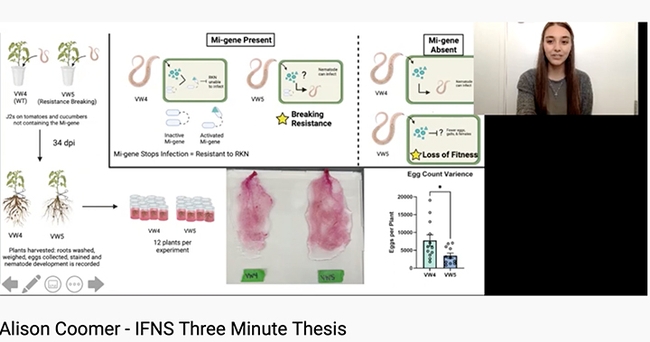- Author: Kathy Keatley Garvey

Alison Coomer, Pallavi Shakya and Ching-Jung Lin are among the record 18 students given travel awards by SON, thanks to industry sponsors. All travel award recipients will deliver a presentation or provide a poster at the international meeting.
Bayer Crop Science will sponsor 10 travel awards, and Microbes, Inc., Certis Biologicals and Corteva, will each sponsor two awards. In addition, the United Soybean Board will provide two travel awards to students presenting nematode research in soybean production.
Alison Coomer
Alison, a third-year graduate student in the Department of Plant Pathology, is focusing her research on plant parasitic nematodes, specifically root-knot nematodes, and their molecular mechanisms to defend against plant immune systems. "I am also working to gain more understanding in the defense mechanism in plants towards plant parasitic nematodes."
Alison, originally from the St. Louis, Mo., region, received two undergraduate degrees from Concordia University, Neb.: a bachelor's degree in biology and a bachelor's degree in chemistry.
"I am very thankful to Cobb Foundation and Mai-Ferries-Bird for receiving one of the most prestigious student awards: Cobb Foundation/Mai-Ferris-Bird Student Travel Award," she said.
In her leisure time, Alison enjoys "the outdoors, animals of all varieties, and serving my community."
Pallavi Shakya
Pallavi is a second-year doctoral student in Siddique lab. "I come from Nepal, the land of Himalayas and I am interested in exploring plant parasitic nematodes from a combination of plant pathology and bioinformatics viewpointism," she related. Pallavi received her master's degree in plant biotechnology from Wageningen University in the Netherlands where she was introduced to transcriptomics of potato cyst nematodes.
"Working with these nematodes showed me the importance of understanding plants along with the parasites they have co-evolved with," she said. "In the Siddique lab, I plan to learn about the genomics and transcriptomics aspects of plant-nematode interaction."
"I am very thankful to Bayer Crop Science for my student travel award, and I am looking forward to meeting all the amazing nematologists in the meeting."
Ching-Jung Lin
Ching-Jung is a doctoral student in the Department of Plant Pathology with a designated emphasis in biotechnology. "I am fascinated by plant-microbe interaction," she said. "Currently I am interested in the development of functional genetic tools in plant-parasitic nematodes and the characterization of nematode-induced plant immunity. Originally from Taiwan, she holds a bachelor of science degree in agronomy from National Chung-Hsing University, and a master's degree in plant biology from National Taiwan University.
"I am very thankful to Bayer Crop Science for funding my student award and I look forward to delivering my presentation at the SON conference," she said. Outside of the lab, Ching-Jung enjoys "reading, jogging, playing badminton, and going to the gym." And, she added, "I am a coffee and dog person."
Research in Shahid Siddique Lab
Research in the Siddique lab focuses on basic as well as applied aspects of interaction between parasitic nematodes and their host plants. "The long-term object of our research," he says, "is not only to enhance our understanding of molecular aspects of plant–nematode interaction but also to use this knowledge to provide new resources for reducing the impact of nematodes on crop plants in California."
SON is an international organization formed to advance the science of nematology in both its fundamental and economic aspects.
"Nematodes are the most abundant multicellular animals on the face of the earth," SON relates on its website. "They occur literally everywhere--in soil and decaying matter from the poles to the tropics, in all forms of plant life, in the bodies of almost all animals, including humans, and in insects. Living in such diverse environments as the sand and mud of the ocean bottom, stony mountain soils, and arid polar deserts are thousands to millions of nematodes per square meter."
SON defintes nematodes as "nonsegmented roundworms with complete sensory, digestive, excretory, and reproductive systems. Most, but not all, are microscopic. The variety of nematode forms and habitats is almost unbelievable: they range from the minute inhabitant of your favorite mushroom to the 27-foot-long parasite in the placenta of a sperm whale."
"Nematodes are essential elements of ecosystems, but most have no direct effect on humans," the SON website points out. "Those that do, however, can be devastating. In many places, people still suffer from diseases such as elephantiasis, river blindness, and hookworm, caused by nematodes. In most places, the effect on humans is indirect. For example, in the United States, plant-parasitic nematodes cause more than $3 billion worth of crop losses each year, and cause similar losses in cattle, sheep, and swine." (See more information about nematodes on its website.)


- Author: Kathy Keatley Garvey
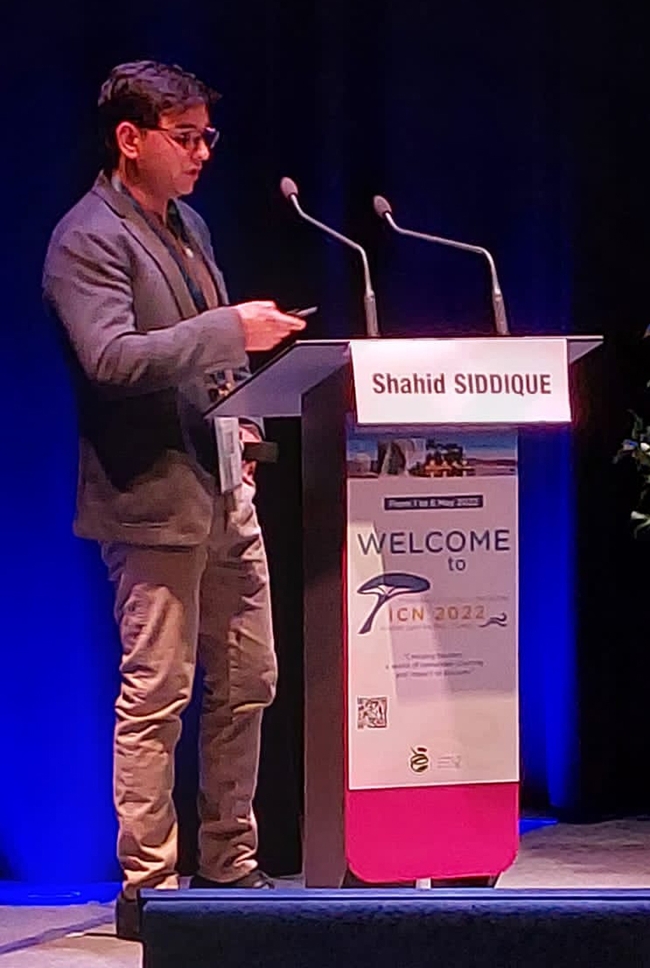
Siddique served as an invited speaker and chaired a nine-presentation session on nematode-plant interactions. He also was elected to the governing board member of the European Society of Nematology (ESN), and will serve a four-year term.
Siddique, who joined the UC Davis faculty in March 2019 as an assistant professor after serving as a research group leader for several years at the University of Bonn, Germany, delivered his address on “How Plants Recognize Nematodes: Signals and Signalling.”
Siddique focuses his research on "elucidating interactions between parasitic nematodes and their hosts using molecular and basic applied methodologies." Plant-parasitic nematodes are destructive pests causing losses of billions of dollars, he says on his lab website. "While these pests have been investigated mainly because they pose a major threat to food security globally, they are also intellectually fascinating due to their highly evolved interkingdom interactions with host plants."
Coomer, who recently won a worldwide competition sponsored by the International Federation of Nematology Societies (IFNS) for her three-minute thesis on root-knot nematodes, presented her award-winning video, “Trade-Offs Between Virulence and Breaking Resistance in Root-Knot Nematode.” She received a busary as well as a certificate signed by ICN president Larry Duncan of the University of Florida and conference chair Pierre Abad of France, a senior scientist at INRA, a French public research institute dedicated to agricultural science. Coomer also showcased her work on a life-sized poster.
IFNS annually hosts the three-minute thesis competition “to cultivate student academic and research communication skills, and to enhance overall awareness of nematodes and the science of nematology.” Coomer, a doctoral student in plant pathology with an emphasis on nematology, is working on her dissertation, “Plant Parasitic Nematode Effectors and Their Role in the Plant Defense Immune System.”
The international meeting, themed “Crossing Borders: A World of Nematode Diversity and Impact to Discover" to reconcile the importance of agricultural production with that of environmental conservation, drew 682 nematologists from 57 countries. Among them were 100 student and early career scientist busary recipients. The scientific program of 32 concurrent sessions included 288 oral presentations, 12 workshops, 12 keynote speakers and more than 500 poster presentations.
It was the first in-person meeting in two years due to the COVID-19 pandemic.
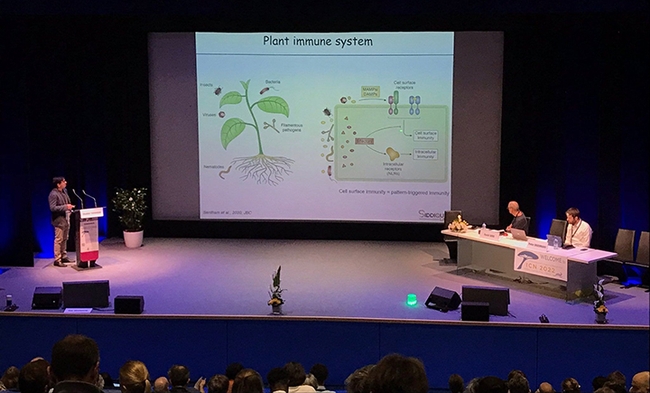
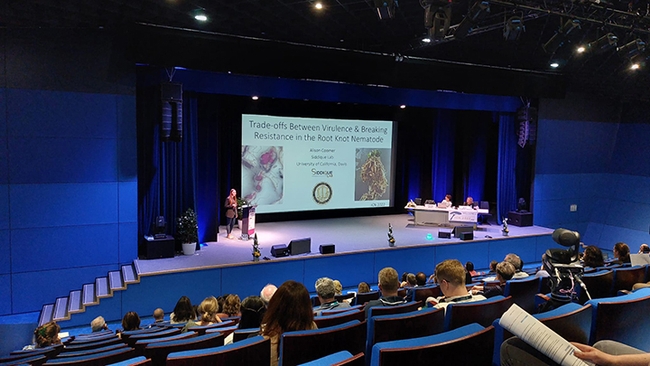

- Author: Kathy Keatley Garvey
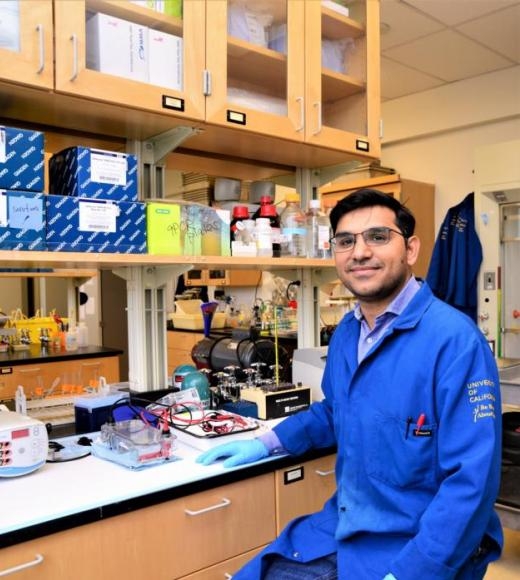
The display will include:
- What's in the jar?
- Celery infected with root-knot nematodes
- Tree swallow infected with Diplotriaena
- White-tailed deer eye infected with a Thelazia species
- Peach root infected with root-knot nematodes
- Mormon crickets infected with Gordius robustus
- Lettuce infected with root-knot nematodes
- Garlic damaged by Ditylenchus dipsaci
- Horse stomach infected with three parasites: Parascaris (roundworms), tapeworms, and botfly larvae.
- Grape roots infected with root-knot nematodes
- Sweet potato infected with root-knot nematodes
- Sugar beet infected with cyst nematodes
- Peach root infected with cyst nematodes
- Sugar beet infected with root-knot nematodes
- Ascaris lumbricoides (roundworm)
- Minke whale infected infected with ascaridoid nematodes
- Heartworm of dog

The event is set for 11 a.m. to 3 p.m. in the UC Davis Conference Center, 555 Alumni Lane. Admission and parking are free, but visitors must adhere to the COVID-19 Campus Ready guidelines. Masks will be required in accordance with campus policies, organizers said. Visitors can also sign up at the Conference Center for limited tours. Several museums or collections will be offering tours. (See news story)
"Plant-parasitic nematodes are destructive pests causing losses of billions of dollars annually," Siddique says on his website. "Economic, health, and environmental considerations make natural host plant resistance a preferred strategy for nematode control, but there are limitations to this approach. In many cases, the resistance conferred by resistance genes is partial, and some of the nematodes are able to survive. Similarly, nematode resistance genes are often effective against only one or a few species, whereas plants are exposed to several pathogens in the field. Another concern is the emergence of pathotypes that can overcome resistance. In view of all these limitations, it is important to identify additional mechanisms and tools that can be used to develop novel and sustainable approaches to the management of nematodes."
"Research in the Siddique lab focuses on basic as well as applied aspects of interaction between parasitic nematodes and their host plants," Siddique points out on his website. "The long-term object of our research is not only to enhance our understanding of molecular aspects of plant–nematode interaction but also to use this knowledge to provide new resources for reducing the impact of nematodes on crop plants in California."
Coomer, a second-year doctorate student, recently won a worldwide competition competition sponsored by the International Federation of Nematology Societies (IFNS) for her three-minute thesis on root-knot nematodes. She delivered her video presentation virtually on “Trade-Offs Between Virulence and Breaking Resistance in Root-Knot Nematodes.” She will be awarded a busary and plaque at the 7th International Congress of Nematology (ICN), set May 1-6 in Antibes, France.
Coomer earlier was selected one of the nine finalists in the 22-participant competition, vying against eight other graduate students from the University of Idaho, Moscow; and universities in England, Australia, Brazil, Ireland, Kenya, Belgium and South Africa.
The UC Davis Biodiversity Museum Day is traditionally held on the Saturday of Presidents' Day weekend. However, last year's event was virtual, and this year's event is centrally located in an exposition. For more information, access the UC Davis Biodiversity Museum Day website and/or connect with Instagram,Twitter, and Facebook.


- Author: Kathy Keatley Garvey

Coomer, a member of the laboratory of nematologist Shahid Siddique of the UC Davis Department of Entomology and Nematology, just won a world-wide competition sponsored by the International Federation of Nematology Societies (IFNS) for her three-minute thesis on root-knot nematodes.
She delivered her video presentation virtually on “Trade-Offs Between Virulence and Breaking Resistance in Root-Knot Nematodes.” She will be awarded a busary and plaque at the 7th International Congress of Nematology (ICN), set May 1-6 in Antibes, France.
Coomer earlier was selected one of the nine finalists in the 22-participant competition, vying against eight other graduate students from the University of Idaho, Moscow; and universities in England, Australia, Brazil, Ireland, Kenya, Belgium and South Africa.
"Our entire lab is glad for Alison winning this award," said Siddique. "This is an outstanding performance and Alison has really been working hard for that. I feel proud about it. I am also looking forward to Alison's presentation at ICN."
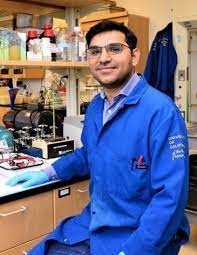
Copeland discussed "Determining the Spatial Distribution of Pratylenchus quasitereoides/Pratylenchus curvicauda in the WA Wheatbelt, and Understanding How They Find Host Roots."
Sheehy's topic: Improving the Biological Control of Slugs: Understanding the Genome of Parasitic Nematode Phasmarhabditis hermaphrodita."
IFNS hosts the competition, IFNS 3-Minute Thesis, "to cultivate student academic and research communication skills, and to enhance overall awareness of nematodes and the science of nematology."
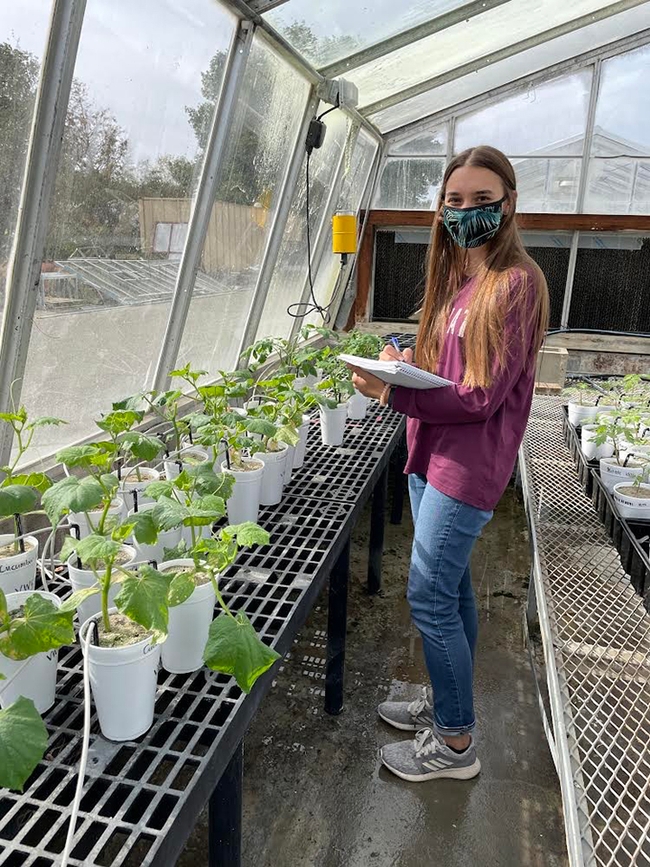
In her presentation, Coomer began with: “Root-knot nematodes, specifically the MIG-group, consisting of Meloidogyne incognita, javanica, and arenaria, are the most damaging of the plant parasitic nematodes causing severe yield loss in over 2,000 different plant species including tomatoes. The Mi-gene, which is a resistance gene in tomato, has been used in commercial farming and has been praised for its effectiveness towards the MIG group. This gene has been cloned but the mechanisms of how it's resistance works is still unknown.”
“We do know that with the presence of the MI gene, plants are more durable and will restrict infection and reproduction, by inducing an immune response within the plant,” Coomer pointed. “Although this resistance gene has been reliable for many decades, resistance breaking strains of root-knot nematodes have emerged threatening the tomato industry.”
Coomer related that her research “compares two strains of the root-knot nematode M. javanica. One strain is the wildtype, which has been isolated from fields, we will refer to it as VW4. This nematode can infect tomato plants, but when the MI gene is present, the nematode is blocked from successfully infecting. The other strain is a naturally mutated version of VW4. This strain breaks the resistance provided by the MI gene and therefore infects plants that contain the MI gene. I have labeled this strain as VW5. With the help of research like mine we can stay ahead of the resistance breaking strains and prevent major crop loss in the future.”
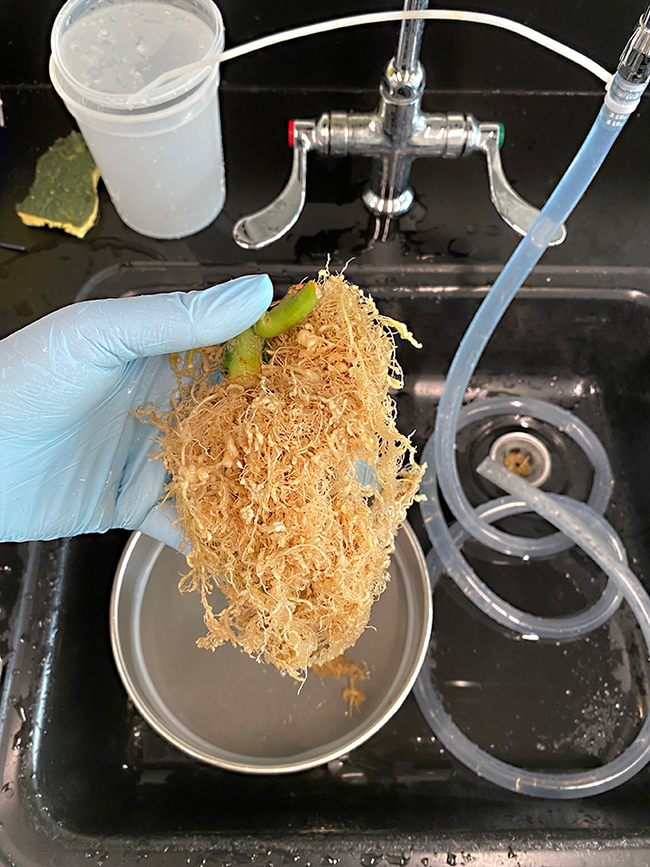
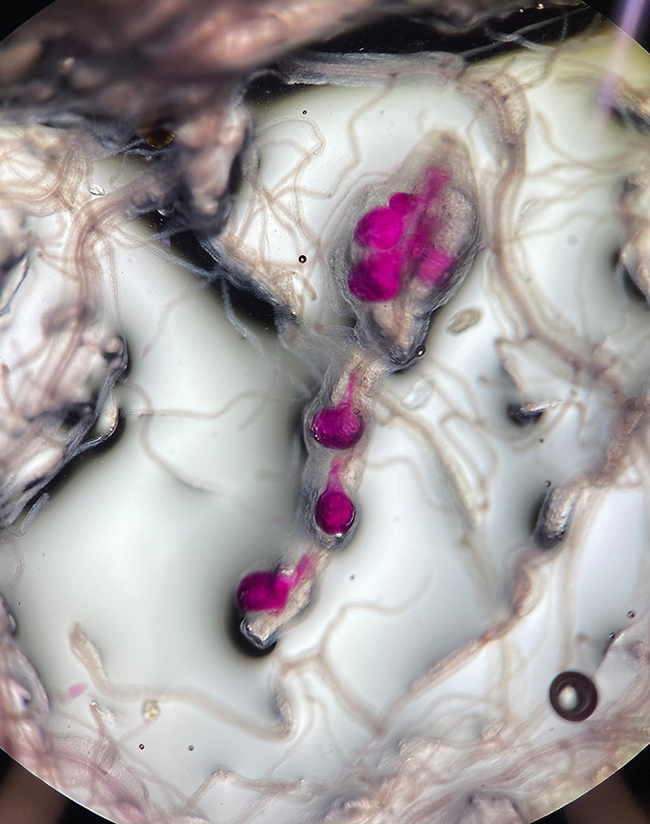
Coomer, a doctoral student in plant pathology with an emphasis on nematology and advised by Siddique, is working on her dissertation, "Plant Parasitic Nematode Effectors and Their Role in the Plant Defense Immune System."
Coomer, originally from the St. Louis, Mo., area, received two bachelor degrees--one in biology and the other in chemistry--in May 2020 from Concordia University, Seward, Neb., where she won the Outstanding Graduate Student in Biology Award. She served as a biology lab assistant and taught courses in general biology and microbiology.
As a biological science aide/intern, Coomer did undergraduate research in the Sorghum Unit of USDA's Agricultural Research Service. Lincoln, Neb. Her work included collecting, prepping and analyzing DNA, RNA and proteins to identify genes that contribute to an under- and over-expression of lignin in sorghum plants.
